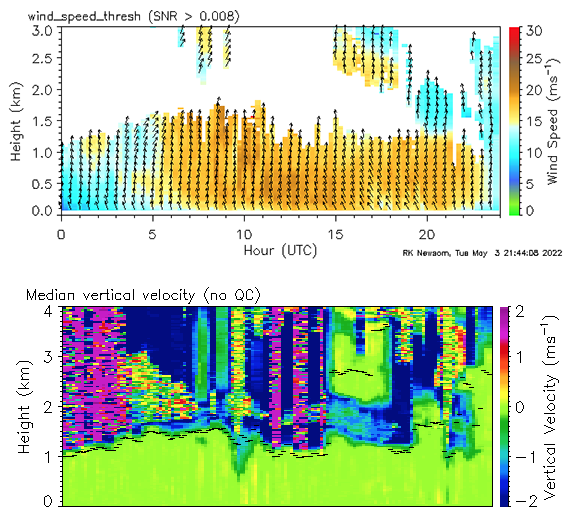Doppler Lidar Data Products Released for 3 ARM Campaigns
Published: 27 September 2022

The Atmospheric Radiation Measurement (ARM) user facility operates Doppler lidars around the globe to provide measurements of radial velocity, attenuated aerosol backscatter, and signal-to-noise ratio. Systems are typically operated using a fixed scan schedule.
Doppler lidar data are used to derive horizontal wind and vertical velocity statistics.
The Doppler Lidar Wind value-added product (DLPROF-WIND VAP) calculates profiles of horizontal winds from plan-position-indicator scans that are performed several times per hour. These wind measurements in the atmospheric boundary layer are particularly important for modeling pollutant and aerosol transport.
The Doppler lidar vertical velocity and cloud statistics (DLPROF-WSTATS) VAP produces height- and time-resolved estimates of vertical velocity variance, skewness (asymmetry), and kurtosis from 1-second vertically pointing measurements. This VAP also estimates cloud properties from the vertically pointing measurements, including cloud base height, cloud frequency, cloud-base vertical velocity, and cloud-base updraft fraction. The Doppler lidar depends on scattering from aerosols, and thus, this VAP only produces data below clouds at heights with sufficient aerosol loading.
Both VAPs are available now for the following three field campaigns:
- the 2019–2020 Cold-Air Outbreaks in the Marine Boundary Layer Experiment (COMBLE) in northern Norway
- the ongoing Surface Atmosphere Integrated Field Laboratory (SAIL) near Crested Butte, Colorado
- the ongoing TRacking Aerosol Convection interactions ExpeRiment (TRACER) near Houston, Texas.
Access the DLPROF-WIND and DLPROF-WSTATS data in the ARM Data Center. (Go here to create an account to download the data.)
More information about the VAPs can be found on the DLPROF-WIND and DLPROF-WSTATS web pages.
For questions about these VAPs, please contact ARM translator Damao Zhang or developer Krista Gaustad.
To cite the DLPROF-WIND data, please use doi:10.5439/1178582. To cite the DLPROF-WSTATS data, please use doi:10.5439/1178583.
Keep up with the Atmospheric Observer
Updates on ARM news, events, and opportunities delivered to your inbox
ARM User Profile
ARM welcomes users from all institutions and nations. A free ARM user account is needed to access ARM data.


















